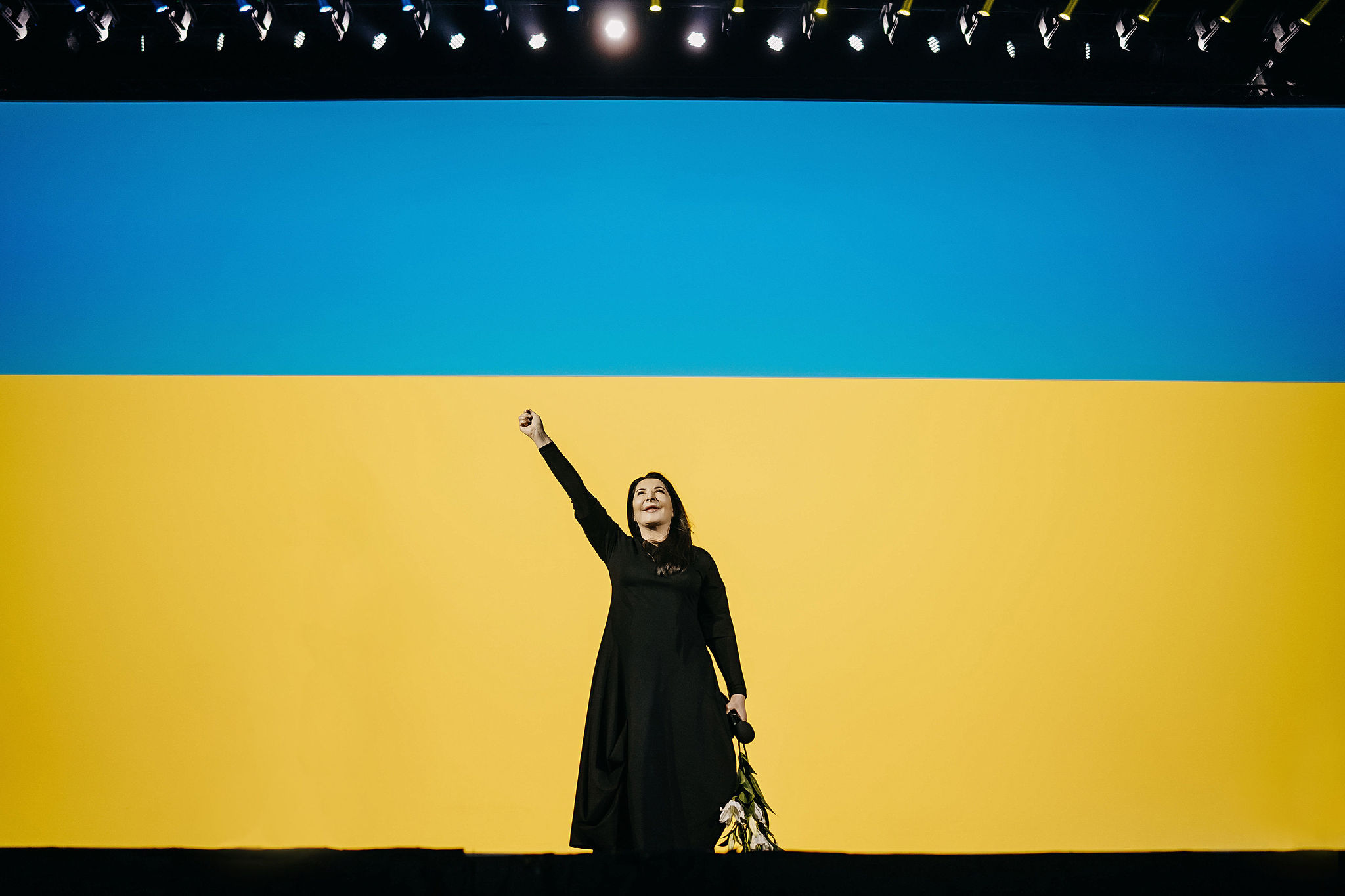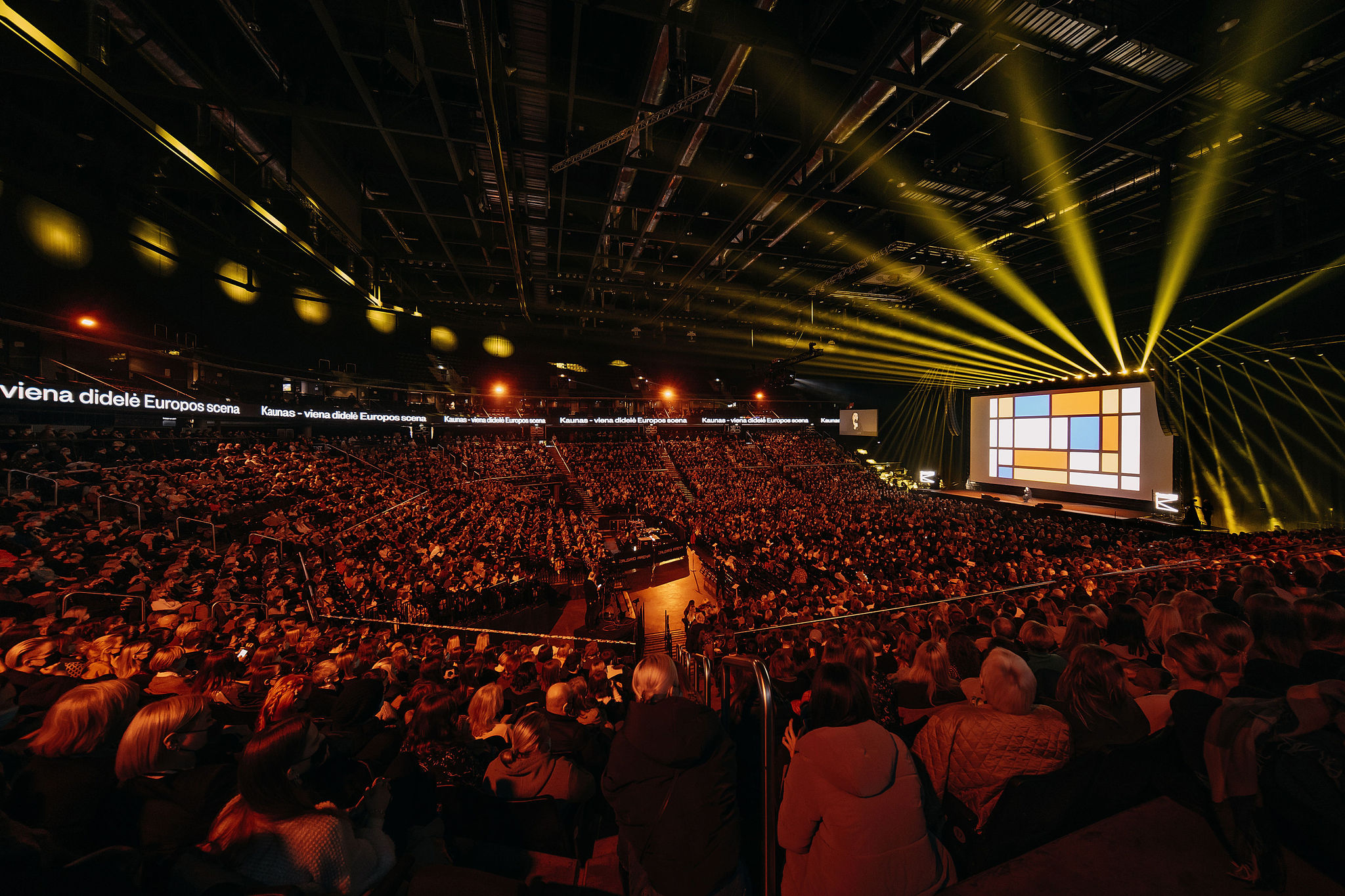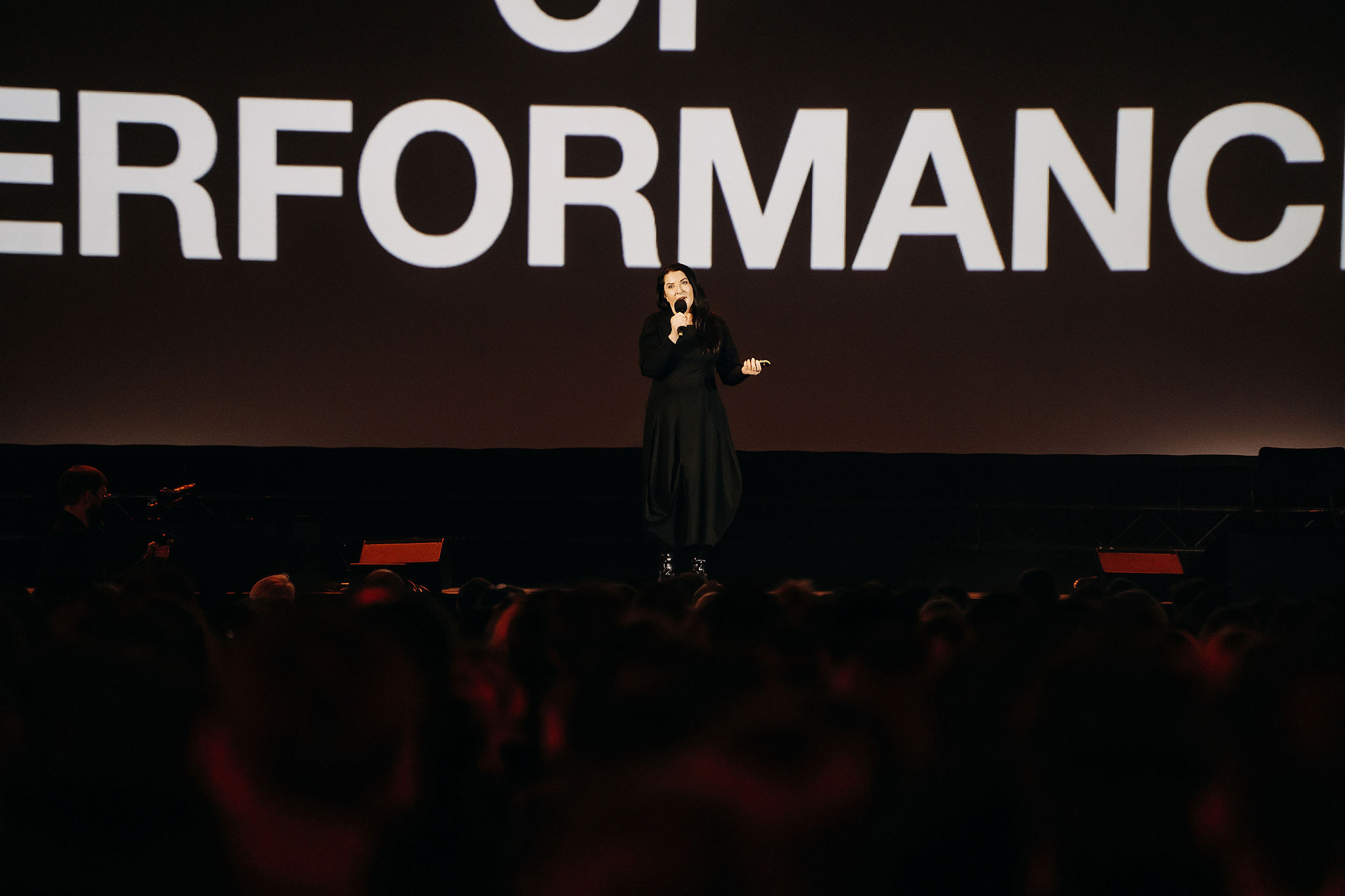Six thousand people, holding each other’s shoulders and sending the energy of love to Ukraine, currently fighting for its freedom. It was not a protest or a rally in the central city square. It was six thousand people gathered in Kaunas on the evening of 31 March to hear Marina Abramović talk about performance art and life in art. The most recognisable art world figure to visit Kaunas started the evening with the following words: “I have an additional part of the lecture because of the current war situation.”

The artist came to the homeland of her friend Jonas Mekas to launch her retrospective exhibition “Memory of Being”. The opening event was accompanied by a lecture “The Past, Present, Future of Performance” at the Žalgirio Arena, which was crowned by an artistic message supporting Ukraine and a short yet impressive Q&A session. This was one of the events of the Kaunas – European Capital of Culture 2022 programme that attracted the most extensive local and international interest.
“This is the biggest audience I have ever had,” smiled the Serbian-born artist as she greeted the people from all over Lithuania and abroad. Abramović, who almost five decades ago switched Yugoslavia for the liberal West, where she blossomed as an artist, gave, in a good two hours, a comprehensive introduction to performance art and its influence on other, often more traditional, fields of art.

References to essential names and their works – performance videos, music pieces, film extracts – were supplemented by insights into the artist’s place in humanity, the Abramović method she has refined to achieve the best possible results, the relationship with the other, and the cost of being an artist, which includes sacrifice, suffering and loneliness.
The fragmentary yet broad perspective of Abramović’s own work became for some a timely repetition of what they have read, heard and seen, as well as a way to make connections before visiting the exhibition at the Kaunas Picture Gallery, while for others, it turned out to be a key to further acquaintance with contemporary art and its seemingly unlimited forms and the possibilities of human mind and body.
“ex-Yugoslavia was a bridge between the East and the West, the Eastern and Western concepts of time – and on a bridge, there is always wind,” the artist began to explain the difference between Eastern and Western concepts of the body. She mentioned that people rely on technology in the West, while in the East, they trust intuition and the power of the body itself. “I have been to the East many times, I have participated in many rituals – not as an observer, but actually to understand how I can best use my body in the best possible way, to push my mental and physical limits – and by learning this, I could take Eastern practices to the West and create art.”
Interestingly, religion and a lack of belief in anything other than oneself are intertwined in the artist’s life. As a child, she was under the care of a very religious grandmother and was later brought up in a more liberal environment; she believes this contrast helped her to learn and maintain the discipline that is necessary for an artist’s practice. “I don’t think everyone can be an artist, and I don’t think artists can change the world – but they can point to important questions; they are servants of society and have to be responsible,” emphasised the guest who visited Lithuania at the invitation of Kaunas 2022 and the Meno Parkas Gallery.
Abramović made several references to Ulay, the recently deceased German performance artist Uwe Laysiepen, with whom she lived and worked for twelve years, exploring, to put it very briefly, the relationship between the couple and their bodies. A large screen in the Žalgirio Arena also showed recordings of several of their performances. “We parted on the Great Wall of China – each of us walked 2,500 km to do it. Why couldn’t we do it over a phone call? Well, we wanted to have a dramatic ending,” Abramović joked delicately. Both she and Ulay were born under the sign of Sagittarius and met on their shared birthday, a coincidence that was symbolised by the performance Rest Energy in Amsterdam in 1980. “It was only four minutes long, it was the shortest, and I thought it was the longest,” recalled the artist. Rest Energy is a piece about absolute trust when your life depends on others. The impression was reinforced by microphones attached to the artists’ chests so that they could hear their hearts beating faster and faster.
Among the names such as Bruce Nauman, Laurie Anderson, Pina Bausch, Alejandro Jodorowsky, Abramović mentioned the Taiwanese-American artist Tehching Hsieh. “I am not inspired by others. Why should I be inspired ‘second-hand’? I go to the source – nature inspires me. But there is one person I call a master. It is Tehching Hsieh. This man only made five pieces in his life. Every piece lasted one year. Then I asked him – what are you doing now? He said – I’m doing life; I am living my life. I realised that he had gone through a transformation – he had reached the highest stage possible for a human being,” the artist told the audience in Kaunas. She says that true Zen is only achieved by doing difficult things because it is very easy to do what you like. Don’t be afraid to explore, don’t be afraid to make mistakes – such seemingly simple advice should not be overlooked if you want to do more than 100%. And, according to Abramović, you need to do 150%.
Although her work explores essential, complex and often difficult themes, a cool head and a healthy sense of humour are integral. “I am going to sit and talk to you; after all, I am 76,” the artist laughed after standing at the beginning of her lecture. She also mentioned the talent to joke when talking about Jonas Mekas, whom she described as a great human being. “I divide the world into two sections – the originals and those who follow. John Mekas was a true original,” Abramović said what the audience received with an ovation.

There were dozens, if not hundreds, of those willing to meet the icon in person. Still, only those who attended the opening of the “Memory of Being” exhibition on Tuesday could get the celebrity’s autographs or take a selfie. However, after the lecture on Thursday evening, a few of the attendees were invited to ask questions. An artist from Ukraine, currently in Kaunas, asked how to start making art after experiencing great pain. Abramović revealed that after the Balkan war, she felt great shame and was highly shocked – she was unable to create for two years; it was just too difficult. In order not to become a daily newspaper with yesterday’s news, it takes time to digest information and to create a work of art that speaks not only about a specific war, the war in Ukraine, but about war in general.” Here, Abramović mentioned her bloody performance Balkan Baroque, which was awarded the Golden Lion at the Venice Biennale in 1997.
On the occasion of Kaunas – European Capital of Culture 2022, Meno Parkas Gallery presents the exhibition “Memory of Being” by the art world icon and performance artist Marina Abramović, which is on show at the Kaunas Picture Gallery of the National M. K. Čiurlionis Museum of Art (K. Donelaičio st. 16, Kaunas) from 30 March to 31 July. The exhibition, which consists of video and sound installations, offers an opportunity to get acquainted with the artist’s creative biography, her famous Manifesto and her unique creative method, as well as to see interviews with the artist and other documentary material and to purchase the catalogue “The Cleaner”, the most comprehensive catalogue of Abramović’s work to date, which has been published especially for the occasion in Lithuanian.
Photos by Martynas Plepys

